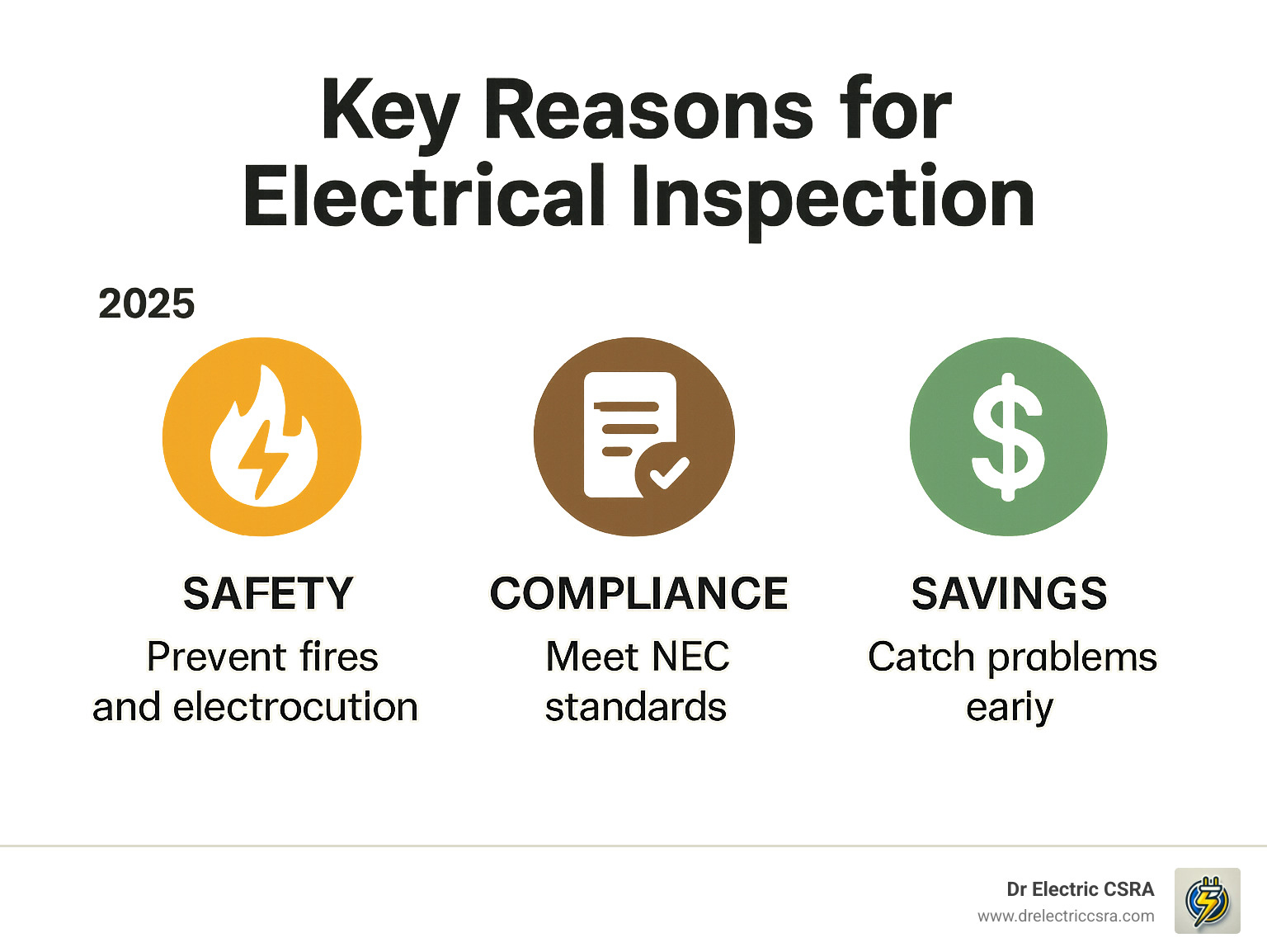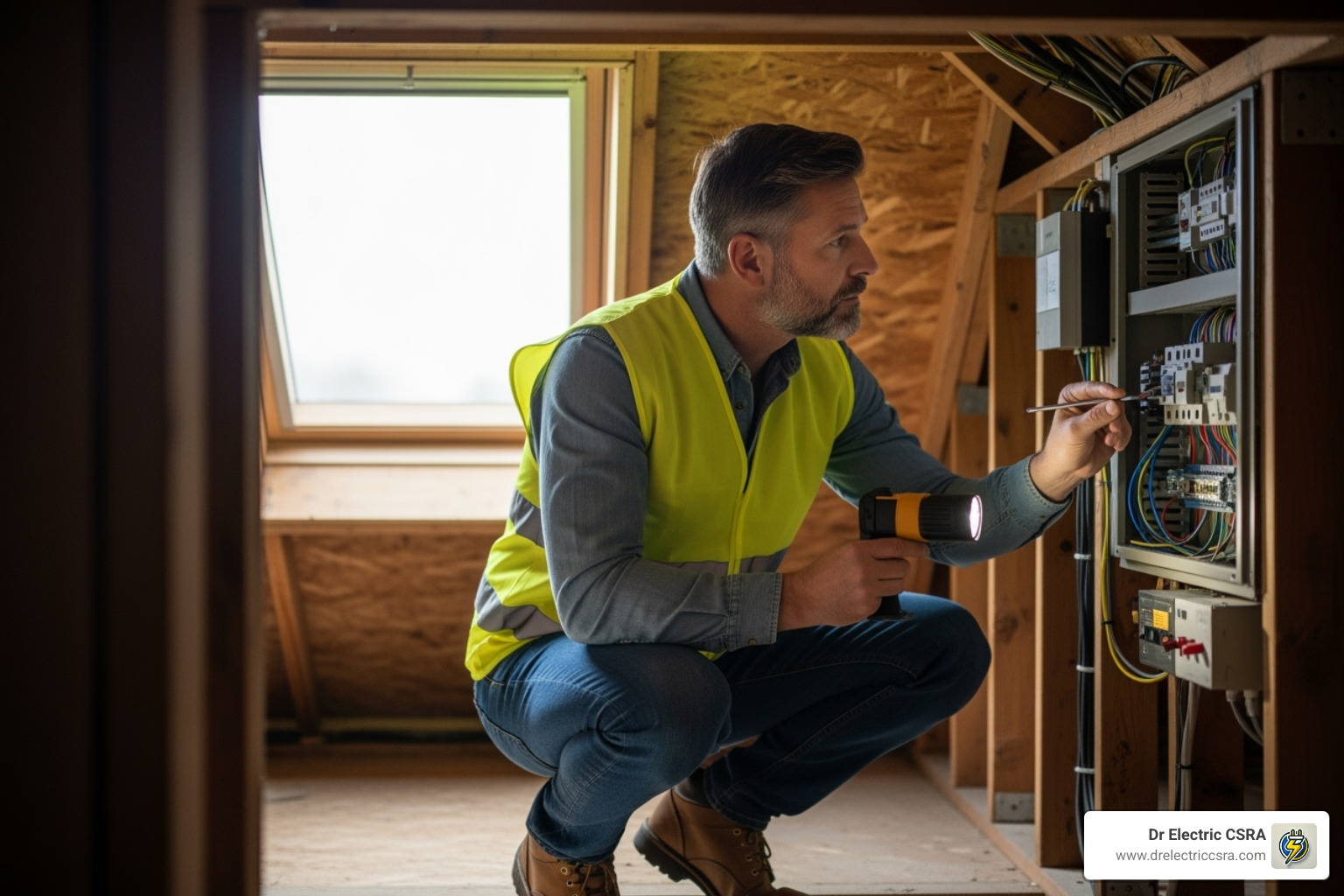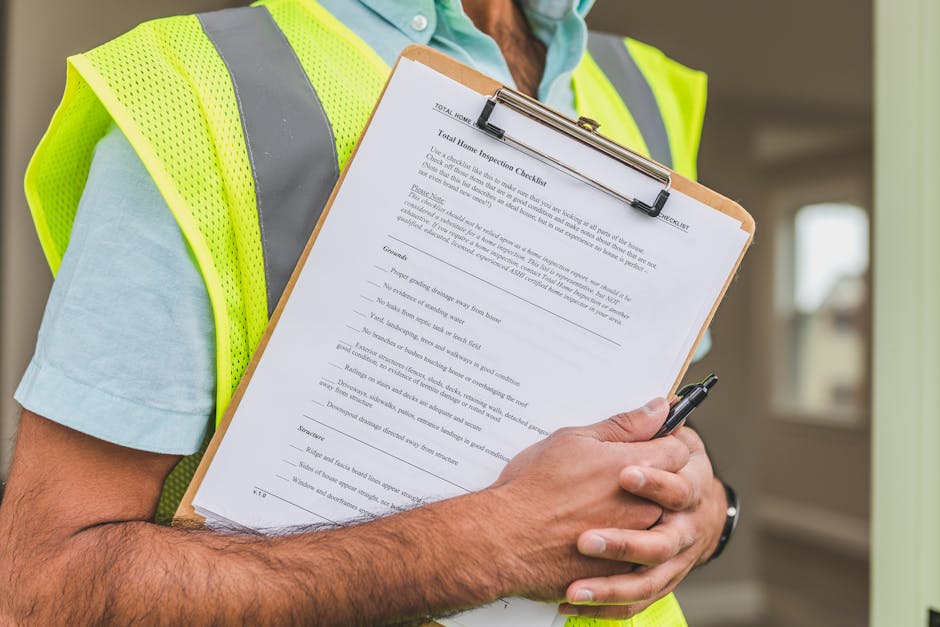Why Your Home’s Electrical Safety Depends on Professional Inspection
Even perfectly good-looking wiring can hide dangerous flaws. A licensed electrician’s inspection is the fastest way to uncover those problems before they spark fires, damage expensive electronics, or void your homeowner’s insurance. In the Central Savannah River Area (CSRA) we routinely see older homes trying to power today’s tech-heavy lifestyles\u0000—from EV chargers to smart appliances. A professional, code-based review keeps your family safe, guards your investment, and delivers the peace of mind that every switch and outlet is doing its job safely.
What is a Residential Electrical Inspection and Why is it Crucial?
A residential electrical inspection is a comprehensive, top-to-bottom evaluation of your home’s entire electrical system. A licensed and certified electrician carefully examines every component, from the main service panel where power enters your home to the individual outlets, switches, and fixtures in every room. The goal is to ensure everything is not only functioning correctly but also adheres to the strict safety standards outlined in the National Electrical Code (NEC)—the nationwide benchmark for safe electrical design, installation, and inspection—as well as specific local ordinances for Augusta and the surrounding CSRA.
The stakes are high. According to FEMA, electrical malfunctions were responsible for an estimated 25,700 U.S. house fires in a single recent year, leading to tragic loss of life and hundreds of millions in property damage. Regular inspections are the single most effective way to shrink those odds, identify ticking time bombs in your walls, and ensure your homeowner’s insurance policy remains valid. Furthermore, an inspection confirms your system is robust enough to handle the demands of modern life, from power-hungry kitchen appliances to a new EV charger in the garage.

The Primary Goals of an Inspection
- Identify hidden hazards: This includes issues like loose connections that can arc and cause fires, conductors overheating within walls, deteriorated insulation from age or pests, and dangerous, unpermitted DIY wiring.
- Verify everything meets current NEC and local code: Electrical codes are updated every three years to incorporate new safety technologies and address emerging risks. An inspection ensures your home isn’t dangerously outdated.
- Confirm proper installation and grounding: A solid grounding system is your primary defense against electric shock, safely diverting stray electrical currents into the earth before they can harm someone.
- Check capacity: Many older homes in the CSRA were not designed for the number of electronics we use today. An inspection determines if your system can support today’s—and tomorrow’s—electrical demand without dangerous overloads.
Types of Electrical Inspections
- Pre-purchase: Essential for homebuyers. An inspection uncovers potential problems, empowering you to negotiate repairs or price adjustments before you commit to buying.
- New construction: These are typically mandated by local authorities at the rough-in and final stages to ensure the home is built to be safe from day one.
- Renovation/addition: Integrating new circuits with an older system is a complex task. This inspection verifies that new work is done correctly and tied in safely to prevent overloads and other hazards.
- Routine safety: Think of this as preventative care for your home. We recommend an inspection every 5–7 years (or 2–3 years for homes over 25 years old) to catch wear and tear before it becomes a critical failure.
- Insurance-mandated: Many insurers require an inspection report, especially for older homes or after a major claim, as a condition for renewing or issuing a policy.
When to Schedule a Professional Electrical Inspection

Proactive scheduling is key to electrical safety. Don’t wait for a problem to arise. Book an inspection when you:
- Buy or sell a property. For buyers, it provides critical insight into the home’s condition. For sellers, it can prevent last-minute deal complications.
- Tackle major renovations or home additions. Any project that adds or alters wiring requires an inspection to ensure it’s integrated safely with the existing system.
- Install power-hungry equipment like a hot tub, a new central HVAC unit, or an EV charger. These devices place a significant load on your system, which must be verified for capacity.
- Recover from storms or floods. Water and electrical systems are a dangerous mix. After any significant weather event, an inspection is crucial to check for damage. Our Storm Protection team can help assess and repair any issues.
- Own a house built before 1999 that has never been evaluated. Homes from this era may have outdated wiring like aluminum or lack modern safety features like AFCI protection.
- Update insurance policies. Your provider may require a certified inspection to confirm the property meets their risk standards.
Red-Flag Warning Signs
If you notice any of these issues, schedule an inspection immediately, as they can indicate dangerous conditions:
- Persistent flickering or dimming lights. This isn’t just an annoyance; it often signals a loose or corroded connection somewhere in the circuit. As electricity struggles to jump the gap, it generates intense heat, creating a significant fire risk.
- Repeated breaker trips. A circuit breaker is a safety device designed to trip when a circuit is overloaded or has a short. If a breaker trips frequently, it’s a clear sign that you are demanding more power than the circuit can safely provide, or there’s a potentially dangerous fault in the wiring or an appliance.
- Buzzing outlets or burning odors. These are emergency-level warning signs. A buzzing sound indicates a loose wire or faulty device arcing electricity, while a burning smell means something is already overheating and melting. Turn off the power at the main panel immediately and call a professional.
- Warm, discolored, or two-prong outlets. Outlets should never be warm to the touch; warmth indicates a bad connection and a fire hazard. Discoloration is evidence of past overheating. Two-prong outlets lack a grounding wire, a critical safety feature that protects you and your electronics from electrical faults.
- Permanent reliance on extension cords. Extension cords are for temporary use only. Using them as a permanent solution indicates you don’t have enough outlets, which can lead to overloading the cords themselves, creating both a trip hazard and a fire risk.
How Often?
- Modern systems: every 5–7 years.
- Homes 25 years or older: every 2–3 years.
- Anytime after significant electrical upgrades.
The Complete Residential Electrical Inspection Checklist: What Inspectors Look For

During more than 1,200 inspections around Augusta, Evans, Grovetown, and Aiken, these eight areas reveal 95 % of issues we correct. A thorough inspection is a systematic process, leaving no stone unturned.
1. Main Panel & Breakers
- Physical Condition: Check for rust, water intrusion, or physical damage to the panel enclosure.
- Breaker Assessment: Test breakers for proper operation, confirm they are the correct amperage for the circuits they protect, and check for overheating signs. We verify there are no dangerous “double taps” (two wires on a terminal designed for one).
- Labeling and Safety: Ensure the panel directory is clear and accurate. We confirm that modern safety devices like AFCI/GFCI breakers are installed where current code requires.
- Surge Protection: We’ll assess if your panel has adequate protection and can offer a whole-home surge protection solution if needed.
2. Wiring
- Type and Condition: Identify the type of wiring used (e.g., modern copper, older aluminum, or obsolete knob-and-tube). We carefully look for damaged or frayed insulation, exposed wires, improper wire gauge for the circuit’s load, and loose splices.
- Junction Boxes: Confirm all wire splices are made inside properly covered junction boxes to prevent accidental contact and contain any potential sparks.
3. Outlets, Switches & Fixtures
- Safety Features: Verify that outlets are properly grounded and have tamper-resistance in required locations to protect children.
- GFCI Protection: Test all GFCIs in required areas like kitchens, bathrooms, garages, basements, and outdoors to ensure they trip correctly.
- Installation Quality: Check for secure wiring, proper support for heavy fixtures like ceiling fans, and ensure light fixtures do not have bulbs that exceed their maximum wattage rating, which is a common fire hazard. Need a new fan? Our Ceiling Fan Installation service covers it.
4. Grounding & Bonding
- System-Wide Check: Ensure the main electrical service, any sub-panels, and all metallic systems (like copper water pipes and gas lines) share a continuous and effective ground path to the grounding electrodes (rods). This is essential to prevent electric shock.
5. GFCI / AFCI Protection
- Device Testing: Manually test every GFCI (Ground Fault Circuit Interrupter) and AFCI (Arc Fault Circuit Interrupter) outlet and breaker in the home to ensure they respond correctly. Any unit that fails the test must be replaced.
6. Smoke & CO Detectors
- Code Compliance: Detectors must be installed inside every bedroom, outside each sleeping area, and on every level of the home. We check their age, as smoke detectors should be replaced every 10 years and CO units every 5–7 years.
- Interconnection: Verify that detectors are interconnected, so when one sounds, they all sound, providing an earlier warning to all occupants.
7. Outdoor & Specialty Systems
- Weatherproofing and Safety: Evaluate all exterior receptacles, landscape lighting, and systems for pools, hot tubs, and generators. We ensure they have proper weather-resistant covers, correct wiring methods, and accessible emergency disconnects.
8. System Capacity & Future Load
- Load Calculation: Measure the actual electrical load on the system and compare it to the panel’s rating. This analysis helps determine if the system is currently overloaded or if it can handle planned additions like an EV, a new HVAC unit, or a major appliance.
Navigating the Inspection: Costs, Consequences, and DIY Checks

Cost & Time
- Basic safety check: $100–$300, 1–2 hrs.
- Comprehensive report: $300–$500, 2–4 hrs, includes infrared and load calculations.
- Price varies with home size, age, and add-ons like infrared scanning.
If the Inspection Fails
- Receive a prioritized report.
- Correct hazards first—our Electrical Repair Services team is on call 24⁄7.
- Schedule a quick re-inspection.
- Ignoring hazards risks fire and may void insurance or delay real-estate closings.
Simple Monthly DIY Checks
- Press TEST/RESET on every GFCI/AFCI.
- Inspect cords and power strips for damage or overheating.
- Feel outlets—stop using any that are warm.
- Keep the panel clear and listen for buzzing.
- Turn off power and call a pro if you ever smell burning insulation.
Frequently Asked Questions about Electrical Inspections
Why do most homes fail?
The most common reasons for failing an electrical inspection include safety hazards that have developed over time or were present from past, unpermitted work. These frequently include ungrounded three-prong outlets, a lack of GFCI protection in wet areas, exposed or improperly spliced wiring in attics and crawlspaces, overloaded circuits, dangerously double-tapped breakers in the main panel, or the presence of outdated and uninsurable wiring systems like aluminum or knob-and-tube.
Can I inspect my own wiring?
While you can and should perform the simple monthly visual checks and GFCI tests listed in this guide, these do not constitute an official inspection. For insurance purposes, real estate transactions, and legal permits, only a report from a licensed electrician who is professionally trained in the NEC is considered valid. An electrician has the diagnostic tools and expertise to uncover hidden dangers that are invisible to the untrained eye.
Home inspection vs. electrical inspection?
A general home inspector provides a broad overview of the entire house, from the roof to the foundation. They typically only perform basic electrical checks, like testing a few outlets and flipping switches. They are generalists, not specialists. A dedicated electrical inspection, performed by a licensed electrician, is a highly specialized and in-depth analysis. The electrician will remove the cover of the main electrical panel (something most home inspectors won’t do), test individual breakers, take load measurements, trace circuits, and evaluate the system against hundreds of specific points in the National Electrical Code. You’ll receive a detailed report with specific code citations and a clear roadmap for any necessary repairs, providing a level of detail and safety assurance that a general inspection cannot match.
What happens after the inspection?
After the inspection is complete, you will receive a detailed, written report from the electrician. This document will outline all the findings in a clear, easy-to-understand format. It will list any areas that are not in compliance with the electrical code, identify any safety hazards, and provide prioritized recommendations for repairs or upgrades. This report is a valuable tool, whether you’re using it for negotiations in a real estate transaction, submitting it to your insurance company, or simply creating a plan to improve your home’s safety.
Ensure Your Home is Safe and Up to Code
Your home’s electrical system is one of its most critical safety features, and regular residential electrical inspections are your best defense against electrical hazards. Think of it as a health checkup for your home’s electrical system – catching small problems before they become big, expensive, or dangerous ones.
The peace of mind that comes from knowing your electrical system is safe and up to code is invaluable. When you can flip a switch or plug in an appliance without worry, you’re experiencing the benefits of proactive electrical maintenance. This isn’t just about following rules – it’s about protecting your family and your investment.
Safety first should be your guiding principle when it comes to electrical systems. Professional inspections identify potential fire hazards, shock risks, and system failures before they put your family in danger. The statistics we’ve shared throughout this guide aren’t just numbers – they represent real families who faced electrical emergencies that could have been prevented.
Proactive maintenance through regular inspections saves money in the long run. Replacing a worn outlet or updating a circuit breaker costs far less than rebuilding after an electrical fire. Plus, a well-maintained electrical system operates more efficiently, potentially reducing your energy bills.
Code compliance protects you from more than just safety hazards. It ensures your home insurance remains valid, prevents legal issues during property sales, and keeps your home’s value intact. As electrical codes evolve to incorporate new safety technologies, regular inspections help your home stay current with these important standards.
For homeowners in Augusta, GA, and the surrounding CSRA, ensuring your home’s electrical system is safe is our top priority at Dr Electric CSRA. We understand the unique challenges that come with our area’s mix of historic homes and new construction. Our team knows local codes inside and out, and we’ve seen how proper electrical maintenance protects families and property.
Trust a professional for your electrical inspection needs. While we’ve shared some basic safety checks you can perform yourself, there’s no substitute for the trained eye of a licensed electrician. We have the specialized tools, knowledge, and experience to spot problems that aren’t visible to the untrained eye.
Don’t wait for flickering lights or tripping breakers to tell you something’s wrong. By then, you’re already dealing with a problem rather than preventing one. Regular electrical inspections are like changing the oil in your car – they’re simple maintenance steps that prevent much bigger problems down the road.
Contact us for all your Residential Electrical needs and schedule your comprehensive residential electrical inspection today. Our experienced team will give you a clear picture of your electrical system’s condition and help you prioritize any needed improvements. Your family’s safety is worth the investment.






0 Comments